Do you set goals with good intentions, only to see them fizzle out? You’re not alone. We did an study of over 2000 people, and it reveals some striking trends in how we approach (and often abandon) our goals.
The good news? These goal setting statistics show us common pitfalls – but they also highlight simple ways to shift the odds in our favor. If you’re looking to boost your career, get healthier, or finally tackle that passion project, understanding the psychology behind goal setting can transform how you achieve your dreams.
Let’s dive into the findings, and explore practical ways to make this the year your goals actually stick!
Goal Setting Statistics
Let’s start with these new 10 goal setting statistics that we recollected from our social media!
1. How Often do You Set Personal Goals?
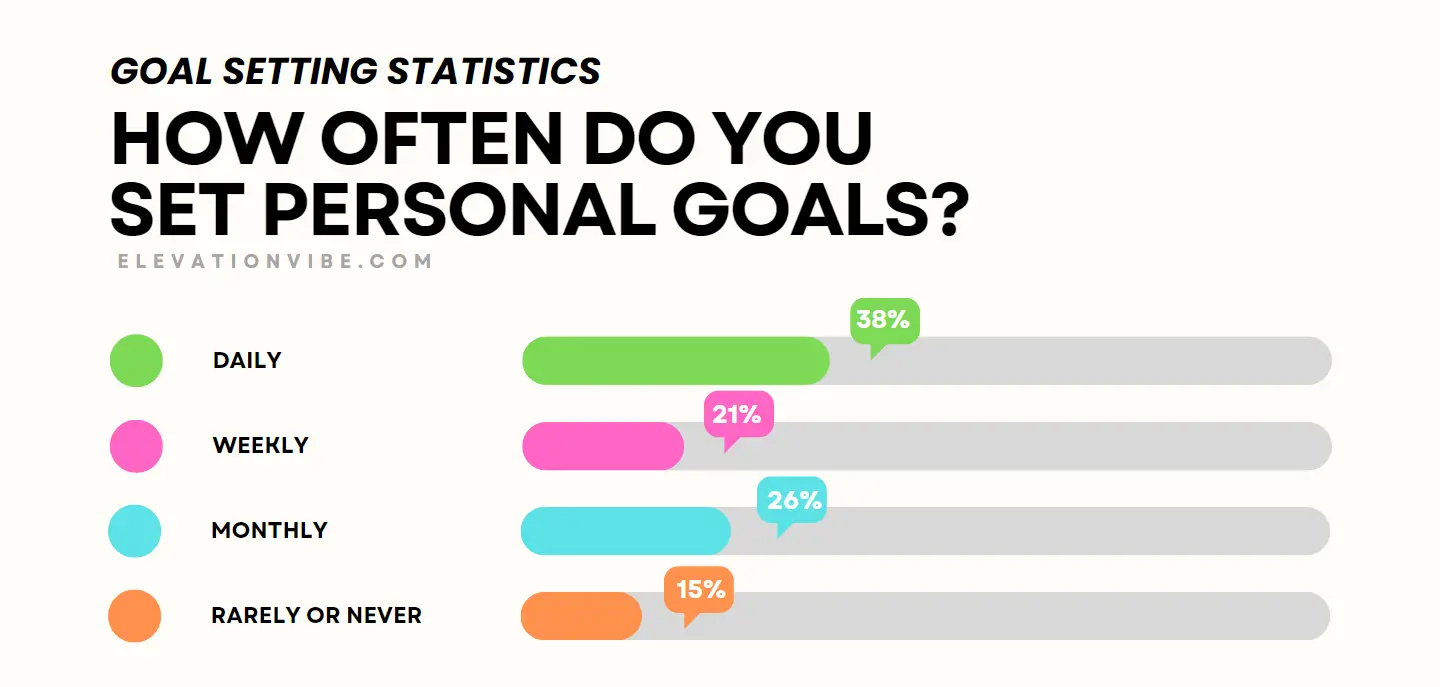
Observations
- The Power of Habit: Daily and weekly goal setters, making up over 60% of the respondents, likely have goal setting ingrained as a regular habit. This consistent practice contributes to a heightened sense of direction and self-discipline, empowering them to chip away at larger ambitions systematically.
- Missed Opportunities: The 15% who rarely or never set goals may be overlooking a major catalyst for personal development. Goals don’t merely provide a finish line; they illuminate the path to get there. Without this guiding light, people risk aimlessly navigating their lives, potentially leaving dreams and aspirations unfulfilled.
- Individualized Approaches: It’s vital to recognize there’s no “one-size-fits-all” answer when it comes to goal-setting frequency. Experimentation is key! Some thrive on the momentum of daily targets, while others prefer the spaciousness that weekly or monthly goals offer for longer-term planning.
If goal setting isn’t currently a habit, that’s completely okay! These statistics point to a beneficial practice, not a rule you must follow.
Experiment to find the right rhythm. Some people thrive on the daily momentum, while others benefit from larger chunks of dedicated planning. There’s no shame in starting off gradually!
2. What Areas of Your Life do you Prioritize?

- Career Dominance: With 42% focused on career and professional development, it’s clear many people see success in their work as central to their overall well-being. This suggests a strong drive for skill expansion, recognition, and the potential rewards of career advancement.
- Emphasis on Health & Fitness: The 33% prioritizing health and fitness signals a recognition that mental and physical well-being are the foundation upon which other successes are built. This points to a likely increase in healthy eating, regular exercise, and mindful stress management practices.
- The Gap in Relationships: Only 8% prioritizing relationships and social life is surprisingly low. It highlights a potential lack of emphasis on meaningful connection, despite studies showing strong support networks are crucial for happiness and resilience.
- Financial Stability’s Significance: Despite financial stability garnering only 17%, it shouldn’t be underestimated. This prioritization reflects a deep-seated need for security and the ability to confidently make future plans.
While this data is insightful, it’s also essential your own life priorities align with your deepest values! Understanding where you stand compared to these overarching trends is a great starting point for reflection.
3. What is your Main Challenge Setting Goals?

The main challenge people face when setting goals is lack of motivation, with 45% of respondents reporting it as their primary hurdle. This highlights the importance of understanding the root causes of motivation, such as fear of failure or lack of clarity, and developing strategies to overcome them.
Here are some tips for overcoming a lack of motivation:
- Identify the root cause: Ask yourself why you’re feeling unmotivated. Is it because the goal is too ambitious? Do you doubt your ability to achieve it? Once you understand the reason, you can start to address it.
- Set small, achievable goals: Break down your large goals into smaller, more manageable steps. This will make them seem less daunting and help you build momentum.
- Find an accountability partner: Having someone to support you and hold you accountable can make a big difference. Share your goals with a friend, family member, or coach and ask them to check in on your progress.
Oftenvercoming challenges is part of the goal-setting journey. By understanding the most common obstacles and implementing effective strategies, you can increase your chances of success.
| Challenge | Percentage of Respondents | Tips |
|---|---|---|
| Lack of motivation | 45% | Identify the root cause, set small goals, find an accountability partner |
| Insufficient time | 10% | Prioritize goals, break down goals into smaller tasks, use time management techniques |
| Limited resources | 18% | Get creative, network with others, consider crowdfunding |
| Unclear objectives | 27% | Reflect on values and aspirations, define SMART goals, visualize desired outcomes |
4. How Do You Track Your Progress Setting Goals?
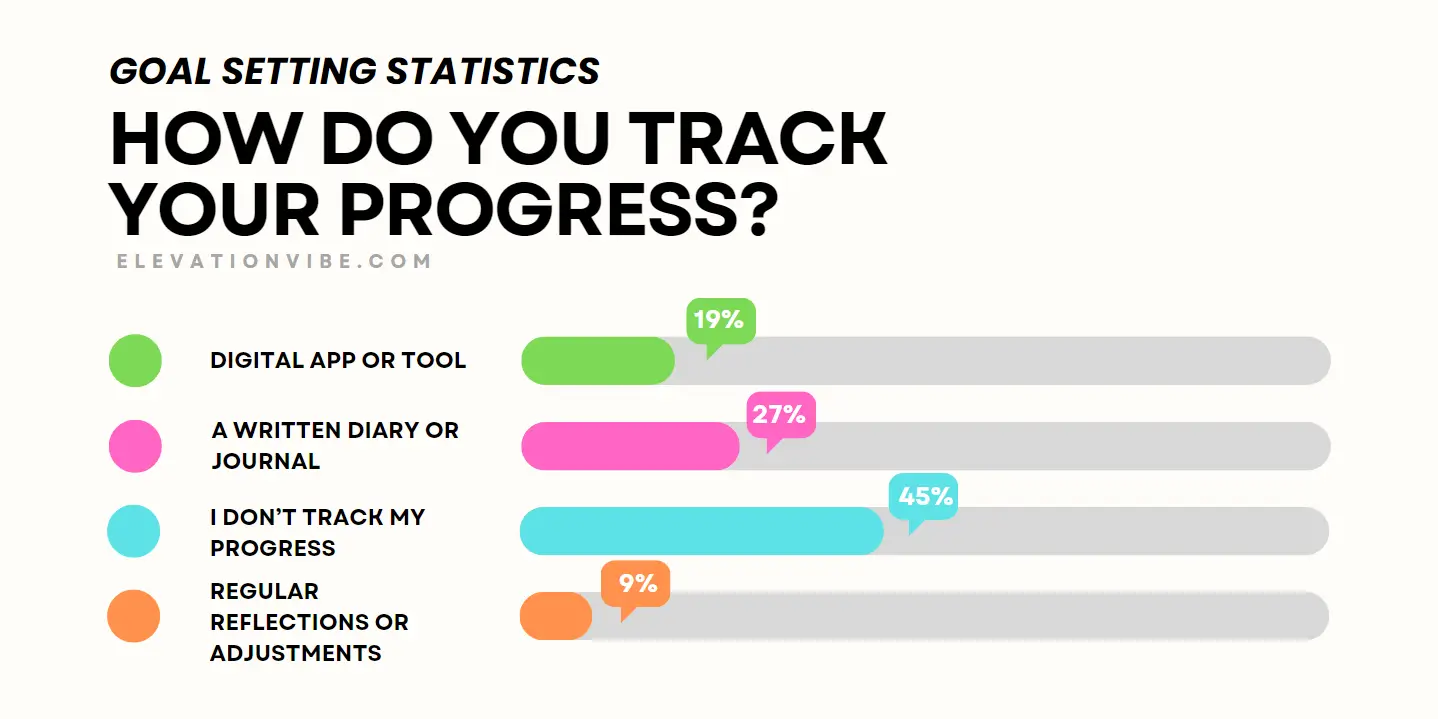
Nearly half (45%) of people don’t track their progress at all, while 27% use a written diary or journal, and 19% use a digital app or tool. The remaining 9% rely on regular reflections or adjustments to stay on track.
Here are some tips for effectively tracking your progress:
- Choose a method that works for you, whether it’s a digital app, a written journal, or regular reflections.
- Set up reminders and notifications to stay on top of your progress.
- Analyze your data regularly to identify areas for improvement.
- Be honest and specific in your tracking to gain valuable insights.
- Use your tracking method to stay motivated and celebrate your achievements.
| Progress Tracking Method | Percentage of Respondents | Tips |
|---|---|---|
| Digital app or tool | 19% | Choose an app that aligns with your goals and preferences. Set up reminders and notifications. Analyze your data regularly. |
| Written diary or journal | 27% | Dedicate time each day or week to reflecting on your progress. Be honest and specific in your journaling. Use your written record to stay motivated and celebrate your achievements. |
| Regular reflections or adjustments | 9% | Schedule regular time for self-reflection. Ask yourself questions like: ‘What went well today?’ and ‘What could I improve?’ Use your reflections to make adjustments to your goals and strategies. |
| No tracking | 45% | Consider implementing a simple tracking method, even if it’s just a list or chart. Regular tracking can help you stay accountable and motivated. |
Remember, the most important thing is to find a tracking method that works for you and helps you stay on track towards your goals.
5. What Motivates You the Most to Achieve your Goals?
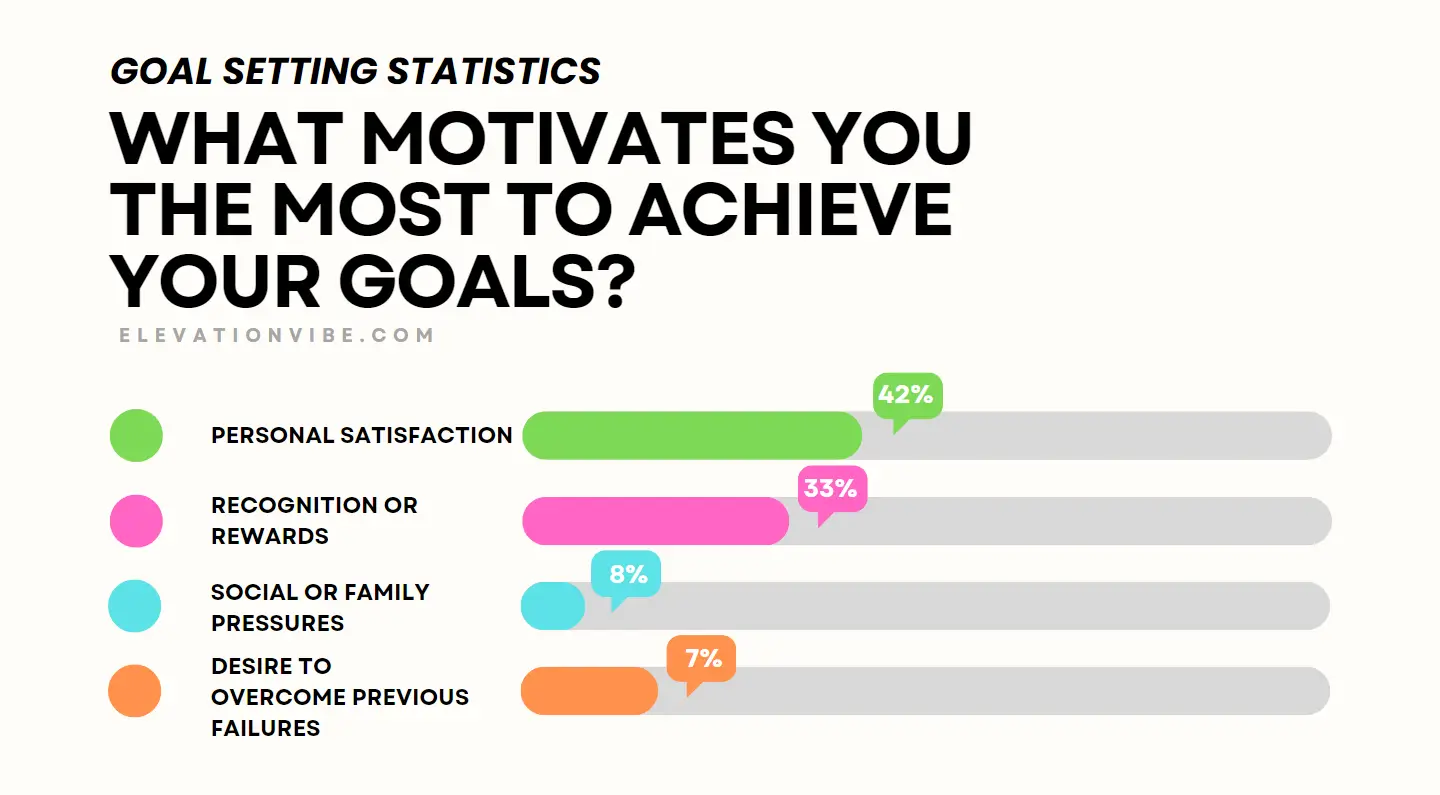
The Power of Intrinsic Motivation
- Personal Satisfaction Dominates: The high ranking of ‘personal satisfaction’ (42%) highlights the power of intrinsic motivation. Achieving personal goals often stems from internal desires like self-development, the joy of mastery, or fulfilling a deeper purpose. This type of motivation tends to be more sustainable than external factors.
- Recognition & Rewards Still Matter: Though secondary, a significant 33% are driven by recognition and rewards. For them, knowing their hard work is seen and valued gives a boost. It’s worth noting what form of reward matters most (praise, financial benefit, tangible incentives) to best target motivation.
Lesser Impact of External Forces
- Social/Family Pressures: The surprisingly low score of 8% implies that the most effective pressure typically comes from within ourselves. It’s encouraging, suggesting most people prioritize self-defined success over meeting external expectations.
- Overcoming Failure: While overcoming failure motivates 7%, it’s interesting this isn’t a primary driver for the majority. This could mean two things: 1- People avoid setting themselves up for potential failure to begin with, or 2- they view setbacks as stepping stones, not a central reason for pursuing goals.
Key Takeaways
- Celebrate your ‘why’: Since personal satisfaction plays a major role, understand what makes achieving a goal intrinsically meaningful to you. Connect with this feeling regularly to fuel your journey.
- Don’t Neglect External Rewards: For some, the right types of rewards can amplify motivation. Experiment to see if small but meaningful recognition strengthens your resolve.
- Healthy Pressure: If social/family expectations are healthy and supportive, they can be a positive, though less dominant, influence. Ensure those expectations align with your own genuine aspirations.
6. Which Method do You Use For Setting Goals?
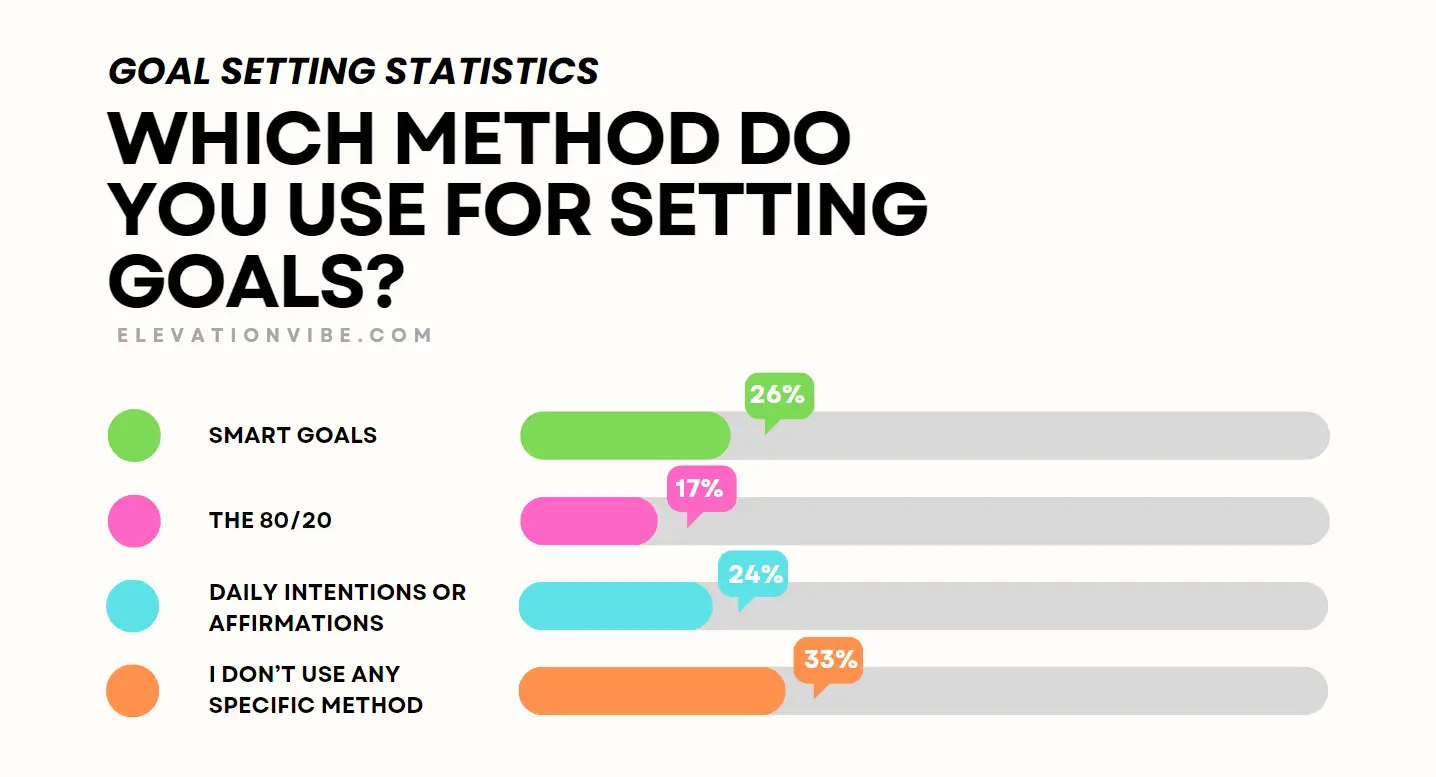
Observations
- No Clear Leader: Interestingly, no single method dominates! This emphasizes the diverse ways people approach goals. The 33% using no specific method suggests either an intuitive approach or possibly, limited awareness of structured goal-setting systems.
- SMART Goals are Established: As an industry standard, the 26% using SMART (Specific, Measurable, Achievable, Relevant, Time-bound) highlights that many actively aim for clarity and practicality when crafting their goals.
- Intentions & Affirmations Gain Traction: Daily focus on intentions and affirmations scoring 24% is notable. It speaks to the growing power of mindset & belief systems within personal development philosophies.
- The 80/20 Rule: Its lower use at 17% could be because it may be seen more as a principle for time management or prioritization, rather than direct goal creation. Yet, 80/20 thinking can inform how goals are structured for maximized impact.
Potential Takeaways
- Personalized Approach: Experimentation is key! You might find combining certain methods proves most effective. Perhaps SMART gives your goals a defined outline, while intentions provide daily grounding in positive vision.
- Education Can Boost Results: For the substantial ‘no method’ segment, exploring even simple structures like SMART could elevate their success! They may be achieving despite not consciously structuring, and introducing helpful systems might increase their odds even further.
7. How do You Usually Respond to Setbacks?

- Resilience Prevails: The majority (45%) take a break and try again, demonstrating persistence and a refusal to concede defeat. This emphasizes the power of a short reset period alongside an overall resilient mindset.
- Seeking Support: A healthy 27% proactively seek advice from others, recognizing the benefits of external mentorship, encouragement, or an objective perspective to overcome the challenge.
- Mixed Reactions to Adjustment: Only 10% directly adjust their goals. This could signal either strong-willed commitment to the original objective or a potential missed opportunity for recalibration when necessary.
- Abandonment Happens: 18% moving on to different goals underscores that sometimes walking away is the right choice. There’s wisdom in knowing when a goal is no longer viable or aligned with larger desires.
8. How Important are Goals in Your Life?
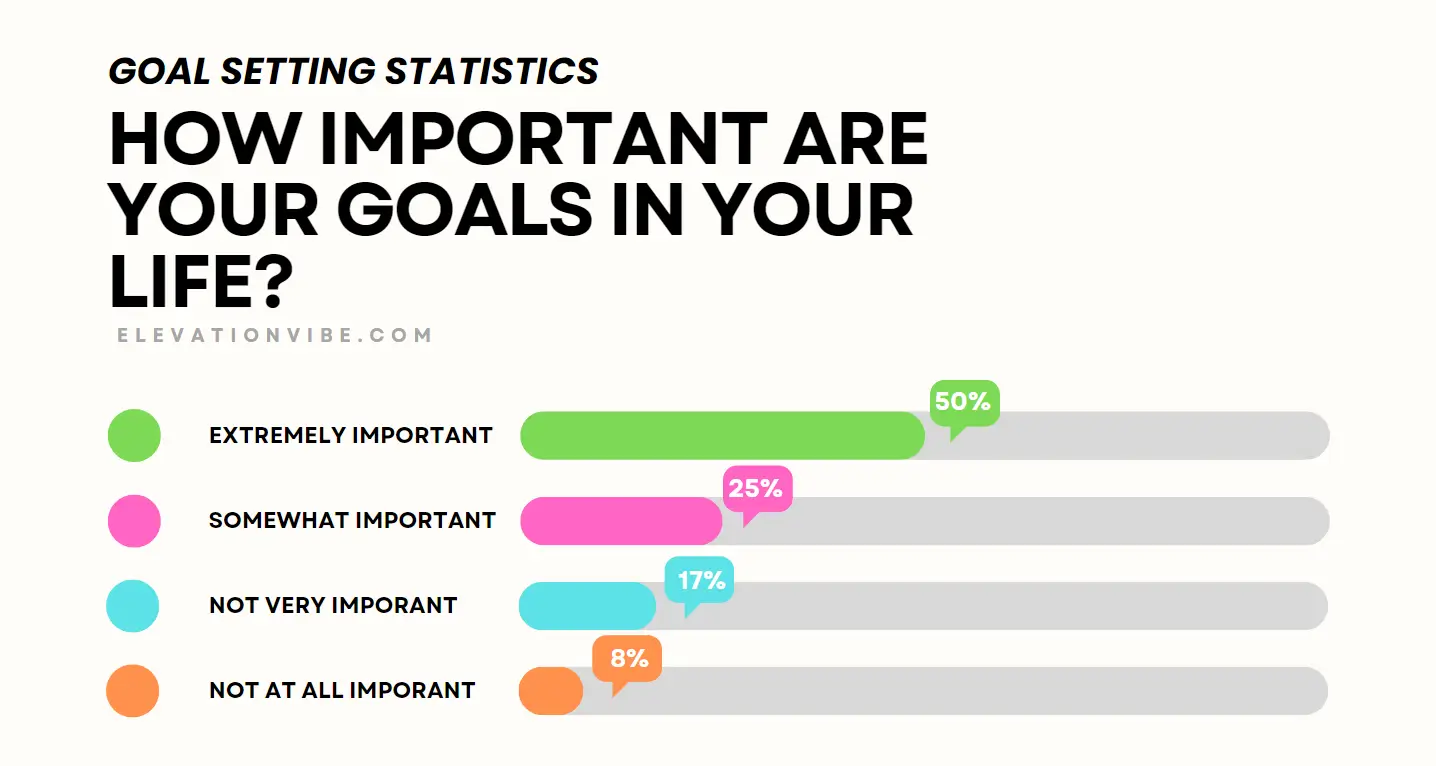
The Power of Goals
- Goals Are Widely Valued: A whopping 75% of individuals believe goals hold at least some importance, with half saying they are “extremely important”. This strongly suggests that most people inherently grasp the power of goals to give life direction, purpose, and motivation.
- Potential for Increased Impact: The 17% for whom goals aren’t very important may benefit from further reflection. Perhaps they’ve had negative experiences with goal-setting, or simply never encountered effective methods. Introducing simple goal-setting principles could greatly enhance their sense of fulfillment and achievement.
- The Vital Few: Even the slim 8% who dismiss goals completely are interesting! Do they operate purely on intuition? Is there a different framework underpinning their decision-making processes? It highlights the diverse ways we navigate life.
Key Takeaways
- Goals Matter to Most: If you fall into the majority valuing goals, this reinforces you’re on the right track! Consider refining your goal-setting methods and reflecting on whether they fully reflect your priorities.
- Don’t Give Up on the ‘Unsure’: If you know someone apathetic towards goals, a gentle explanation of their benefits with clear examples might foster a new perspective.
- Goals Aren’t for Everyone: A small segment will thrive without consciously defined goals. The emphasis here is on knowing thyself and embracing the methods that generate the most meaningful results for YOU.
9. The Journey is more Important than the Destination…
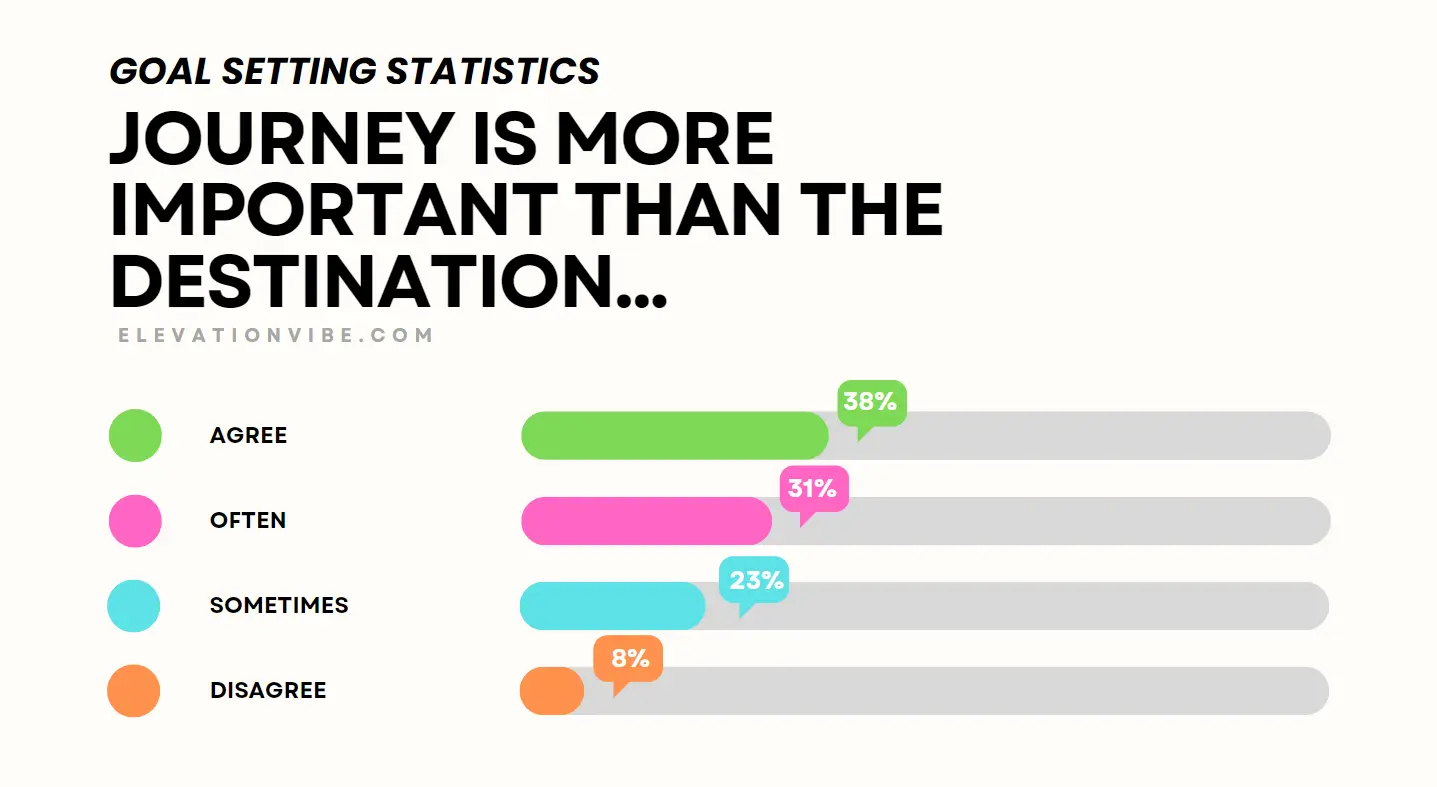
Observations
- Importance of the Journey: With 38% fully agreeing and 31% saying it’s often true, more than two-thirds value the process at least as much as the end goal. This emphasizes the potential for transformative growth occurring along the way
- Situational Factors: The 23% falling into the ‘sometimes’ category indicate a belief that it depends on the situation. Certain goals might warrant intense focus on the outcome, while others blossom by focusing on learning and development throughout the process.
- The Dissenting Few: It’s worth noting 8% outright disagree. Whether due to result-driven personalities or valuing outcomes that hinge on an exact target (financial goal, sports achievement, etc.), it highlights there’s no universally ‘correct’ way to view this question.
Points for Reflection
- Your Goals, Your Call: Consider your own beliefs on this Are there types of goals where the journey matters most to you? Others where reaching the endpoint is paramount? Understanding this gives your efforts focus.
- Reframing ‘Failure’: If you embrace this philosophy, even goals you ultimately don’t reach still yield value due to lessons learned and the person you become during the attempt. This mindset fosters resilience and a less fear-based approach.
- Celebrating the Everyday: It’s all too easy to fixate on an endpoint for long periods. Embracing the ‘journey’ encourages enjoying smaller successes and the day-to-day wins that make achieving greater ambitions possible.
"Life is a journey, not a destination"
 Ralph Waldo Emerson
Ralph Waldo Emerson 10. How Much do You Care about Your Mental Health?
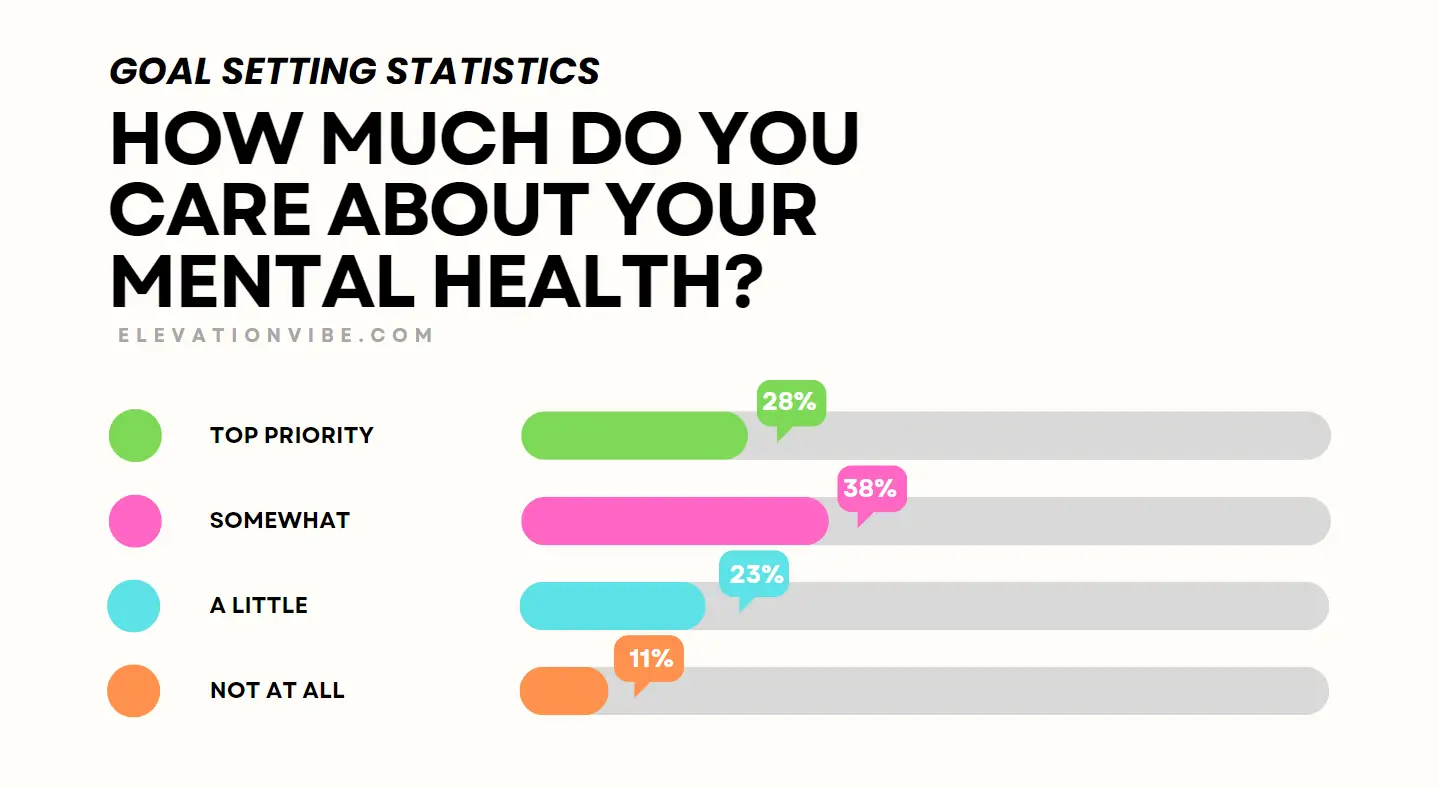
Positive Trends
- Growing Recognition: Over a third (38%) consider it “somewhat” important, and a strong 28% make it their “top priority”. This suggests a positive shift in prioritizing mental well-being alongside physical health.
- Room for Improvement: The combined 34% who see it as “a little” or “not at all” important is a concern. This might signify lack of resources, stigma, or limited understanding of mental health’s impact on all aspects of life.
Key Observations
- Priority Spectrum: This data emphasizes that caring about mental health isn’t simply a yes/no question. Different life stages, current challenges, and access to support resources contribute to varied levels of focus on this area.
- Addressing Apathy: 11% not caring points to the need for greater education and destigmatization around mental health issues. If resources exist but aren’t used, a shift in social narratives needs to happen alongside practical help.
Just as you tend to your physical health, remember that your mental well-being deserves ongoing support and attention too! Small tweaks can create a big difference in how you feel and function over time.
Disclaimer
The information presented on this article is for informational and educational purposes only. It is not intended to be a substitute for professional mental health advice, diagnosis, or treatment.
Always seek the guidance of a qualified mental health professional or physician with any questions or concerns you may have regarding your mental or emotional well-being. If you are experiencing a mental health crisis, please seek immediate help (see resources below).
Mental Health Resources in the US
- National Suicide Prevention Lifeline: Call or text 988 for 24/7 confidential support in a crisis. You can also visit 988 Suicide & Crisis Lifeline: https://988lifeline.org/.
- Crisis Text Line: Text HOME to 741741 from anywhere in the US to connect with a trained crisis counselor.
- Substance Abuse and Mental Health Services Administration (SAMHSA) National Helpline: Call 1-800-662-HELP (4357) or visit SAMHSA’s Website: https://www.samhsa.gov/ for information on support and treatment options.
- National Alliance on Mental Illness (NAMI): Find support groups, educational resources, and advocacy programs at NAMI’s Website: https://www.nami.org/.
- The Trevor Project If you’re a young person in the LGBTQ+ community struggling with your mental health, contact The Trevor Project at 1-866-488-7386, text START to 678678, or visit The Trevor Project’s Website: https://www.thetrevorproject.org/.
You are not alone. Help is available, and seeking support is a sign of strength.
Conclusion
So, how do we make the most of this data on goal setting? Whether you’re a daily goal-setter or just getting started, this snapshot has hopefully illuminated common practices, hurdles, and mindset shifts along the journey. Remember, goal setting is inherently personal, and there’s no one-size-fits-all formula.
The most important takeaway is simply this: having goals matters! While methods might vary, they help us prioritize, create momentum, and build resilience as we move towards the life we want. Celebrate every goal you set, every obstacle you overcome, and always embrace the journey as its own powerful form of success.
These statistics were gathered from our amazing followers on Instagram. If you found this insightful and want to participate in future blog discussions, be sure to follow us there to join the conversation!




